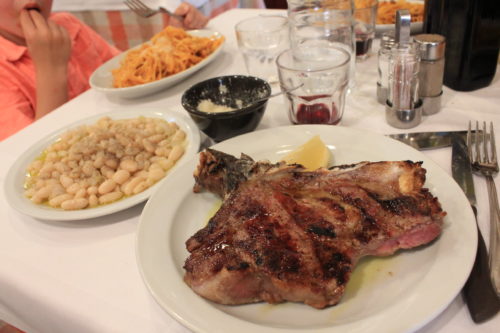 “To be able to say how much you love is to love but little.”
“To be able to say how much you love is to love but little.”
– Petrarch
By mid-morning, the air was vibrating almost audibly, the cicadas had exhausted themselves and gone silent, and the leaves of the sprawling fig hung limply. By noon, the sunlight and heated air had turned the sky from cobalt blue to almost white, and those fools who weren’t in the pool already, would race, wincing with every step, across burning concrete before flinging themselves in.
The walk from pool to apartment for lunch was, I imagine, similar to the experience of a fish being baked. It starts out with a pleasant introduction from coolish water into warm air, then before you know you are scorched and starting to flake. Haste is typically not recommended in such conditions, but flanked on both sides by the brick and rubble walls of Tuscan farm buildings radiating heat like a blast furnace, our saliva evaporated on our tongues and we were forced to run for shelter.
Lunches of cool salads, sun-warmed figs on which goat cheese immediately slumped into weary pools, and carafes of chilled Orvieto were about as much as we could prepare let alone be bothered eating. Post-prandial siestas, even for our energetic kids, became not just unavoidable, but desirable, as the week wore on.
It’s common among the British to nickname extraordinary weather events, and even those not so extraordinary ones. Examples from this past winter include the snowstorms “Beast from the East” and “Baby Beast from the East” which followed one another. Whilst living in London I experienced “The Big Freeze” in which icy temperatures approached 28F/-2C and a “blizzard” dropped almost three inches. And, in spite of being foretold with increasing hysteria no less than a week in advance by a shrill Scottish meteorologist on BBC London, it wrought havoc on the city’s transportation network. Buses were unable to navigate streets with even the most modest inclines and, inexplicably, large parts of the underground system were shut-down.
So it was that, last August, when I heard in the British press that central Italy was “bracing” for the arrival of a heatwave monikered “Il Inferno”, my assumption was that this was nothing more than the usual hyperbole, an excuse for lazy sub-editors to dust off their repertoire of Italian clichés. And in case I was wrong, I consoled myself with the thought that, at worst, we’d be forced to seek shelter and cool off with an extra carafe of wine.
As it turned out, in a reversal of conventional national caricatures neither the British nor the Italians were exaggerating, at least not in this case. Most days it was in the middle-80s by nine am and one had to rise early to enjoy the cool, rosemary-scented dayspring before the tyrannous sun forced a retreat. It’s perhaps no surprise then that in the face of this incandescent sun, noble plans to finally visit many of the hill towns we had failed to get to on either of our two previous stays at Tenuta Lupinari literally vaporized.
It was only after a lazy few days, a combination of boredom and frustration at our own idleness encouraged us to think that we might have acclimatized ourselves enough to at least brave a visit to a vineyard. Such ideas were elaborated upon to take in the wares of a salumeria and a cheesemaker, and turned into a sweaty, but enjoyable day in Montepulciano that emboldened us (after a precautionary day of poolside rehydration) to visit the nearby city of Arezzo.
Naïve assumptions were made about the cooling effect of the interiors of its myriad ancient churches, the level of interest two under-7s would demonstrate towards the Casa del Petrarca, and the suitability of the weather for a lunchtime picnic in the large, leafy park that sits above the city. Not to mention our own stamina up and down cobbled streets in Saharan conditions.
In fact, leaving the Lupinari estate earlier than usual within the relative coolth of the morning, we were excited for a memorable day out. Winding up the Val d’ Ambra and over to the Valdichiana beneath a prematurely yellowing canopy of holm oak there was not another soul on the road. Tied to a post, sun-perished balloons bobbed slowly in the dry breeze and announced the location of “Louise and Jules'” wedding. The sight provoking the thought that local drivers making the journey between Ambra and Bucine some 10 years ago would have been regularly reminded of where Amy and Jonny got married before our balloons finally succumbed to the conditions.
As we crested the watershed, the fearsome sun struck us face-on, instantly turning our car into a microwave from which the feeble air-conditioning offered no relief. But there, shimmering in the haze, across the tan stubble of cropped wheat fields, lay Arezzo, city of Petrarch. Ugly outskirts clustered around traffic circles sprawled at the feet of the promontory up which the historic districts climbed. The serpentine veins of narrow streets beckoning us with their promises of shade.
We parked in a lot underneath one of Arezzo’s many piazzas and emerged into the glare. A pigeon fluttered lazily away, turning to glare at us for having made it move. We crossed the street towards the Basilica of San Francesco. Dedicated to St. Francis of Assisi, the rough unfinished exterior of this 13th-century church is in stark contrast to the famed beauty of its frescoes including “Legends of the True Cross” by Piero della Francesca, and, we hoped, for its cool interior. Sadly, they were admitting no more visitors before lunch and though we could not inspect them close at hand, we were able to admire some of these magnificent scenes by craning our necks in the doorway while, outside, our kids had begun expressing their appreciation for medieval architecture by climbing the façade.
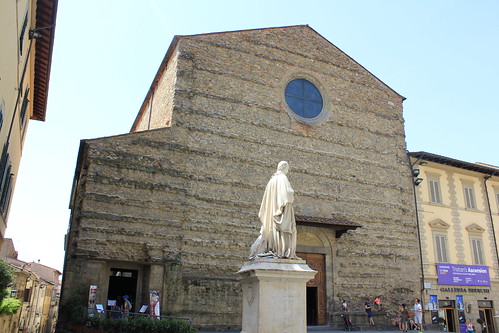
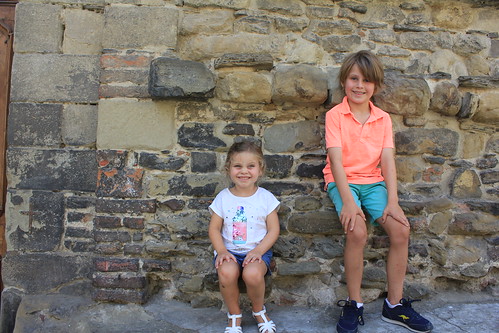

Thinking that we’d only get away with a brief visit to the Casa del Petrarca before the kids got bored, we pushed on uphill for quick blast around before lunch. Allegedly built on the ruins of the house in which the inventor of the sonnet and father of Humanism was born, the museum was also shut for lunch. Indeed, whether shut for lunch, the summer, or more permanently, we could find little that was open in Arezzo that morning. Pushing one child over uneven cobbles in a stroller and carrying one on my shoulders while Amy vainly consulted guidebook and map, we retreated from several promising lunch-spots finding them shuttered and silent.
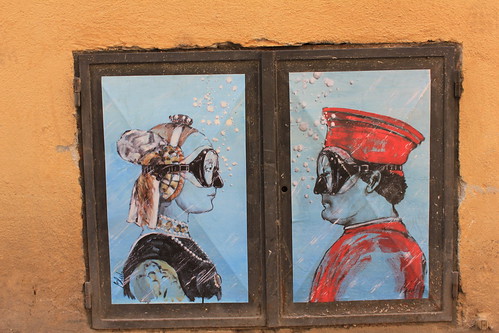
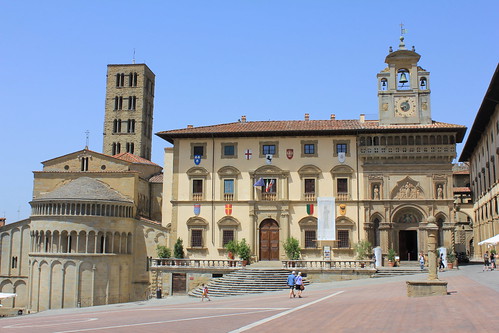
It was only after turning back downhill towards the car bathed in sweat and approaching despair, that we spied Antica Osteria L’Agania, a spot, unbeknownst to us at the time, recommended by Frances Mayes in her picture-book/memoire In Tuscany. So far that week, we had been reluctant to cook much more than some pasta for fear of making our apartment uninhabitably hot, so the prospect of an air-conditioned dining room in which we could treat ourselves to all manner of hearty Aretino specialties was one we could not, and did not, pass-up.
Sharp local pecorino and speckled rings of fennel salami preceded fresh, hand-rolled pastas, almost dandelion in color with yolky brightness, tossed with fresh tomato sauces and rich game ragus. Silky local red wine in a liter carafe arrived at the table still-dripping having been freshly-pulled out of a cold-water filled sink . All of this as prelude to a gargantuan Fiorentina. A T-bone steak cut two hands thick from one of the neighboring valley’s giant, white Chianina cattle – a field of which we had passed earlier in the week on the way to Montepulciano – charred to a chewy, slightly bitter crust and sprinkled lightly with crisps of sea salt. Its melting interior – the juices of which melded lovingly with a bright, grassy local olive oil and a plate of tender sage-infused cannellini – was minerally with a hint of hay sweetness.
I had tried to order only a modest half kilo, but whether victim of a cunning upsell technique, or the reality that Fiorentinas are not cut any smaller, I had consented to this hulking 32oz lump of beast. It certainly wasn’t the perfect weather to be ingesting such immoderate quantities of meat, and nobody else in the restaurant was tackling anything heavier than a plate of tagliatelle, but for all the incredible food we had enjoyed on previous visits to Tuscany – perhaps amazingly given our acknowledged carnivorous proclivities – a bistecca like this had been absent. And, with the consideration that we had expected to return to this region many years earlier than we had managed it, I decided not to wait for milder conditions.
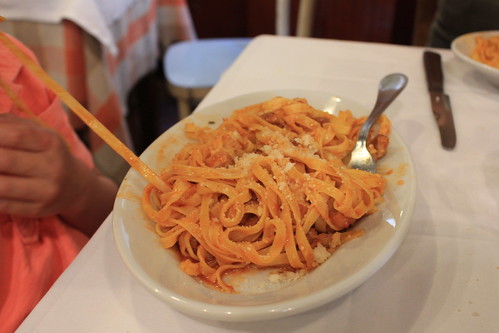
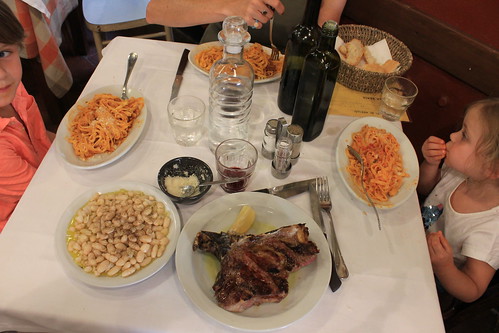
Naturally, the steak was magnificent. Truly wonderful. People pay more than twice as much in swanky steakhouses across America for steaks less than half as good, and after 45 minutes or so of contented munching I was almost surprised to look down and find only bone. That serenity lasted until we returned to the searing streets and, seeking shade and a breeze, headed uphill to the Passeggio il Prato and Arezzo’s cathedral of saints Peter and Donato. During that climb the steak hung like a boulder in my gut and its juices flowed out of my keening pores like oil squeezed from a rock.
There, soaked again in thick sweat and with expectations that I might well faint, I spied buzzards circling lazily on zephyrs, their shadows playing over the baking rooftops, biding their time until a stupid tourist pegged it from the heat. An elderly couple shuffled slowly under the mottled plane trees toward a park bench, their feet crunching brittle leaves asunder. The only things that moved any faster were a skittering lizard on the stone rampart and our children, now energized by fresh pasta and stracciatella gelato, as they ran towards the park’s climbing frame. Even they began to flag after 20 minutes in the brutal heat, so via a brackish water fountain we sought shelter in the cathedral.
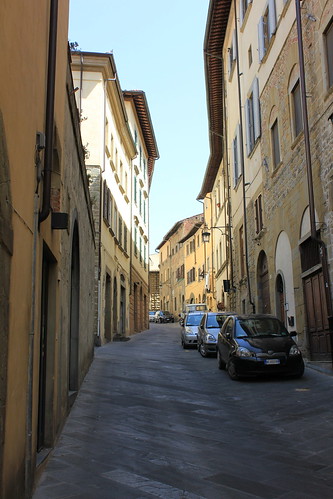



It took several moments for our eyes to adjust from glare to gloom and for our inflamed skins to turn to goose-pimples in the sudden chill. Light flooded through a red and green stained-glass window, casting an aura on the floor that, perhaps appropriately, reminded one of Tabasco sauce. Scattered around the pews sat a score or so similarly desiccated tourists, some head in hands, one supine across a bench. I was halfway to slipping my shoes off and placing my swollen feet on cold flagstones when I noticed the reproachful stares from a black-shawled crone. To atone, we retreated to a side chapel and lit a candle, but could not stop our kids blowing it and all the other candles out birthday cake-style.
Retreating from some energetic tongue-clucking, we emerged once again into the baking afternoon. Mercifully, in spite of the chafing of sweat-dampened clothes, we tottered back down to the car dodging in and out of the lengthening shadows. The winding drive back towards Ambra and then Bucine was remarkably tranquil as worn-out kids drank thirstily in the back seat while we fantasized about slipping into the restorative waters of the pool.
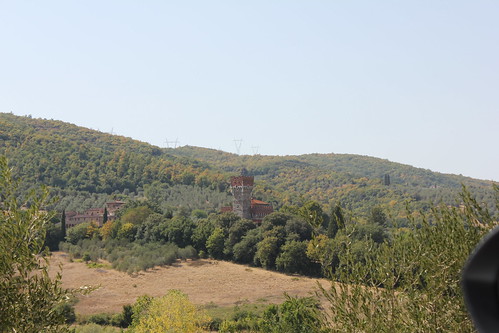
If anyone (still) reading this post was among our first readers (or, even less likely, has plumbed the depths of our archives), they may just recall that we began writing We Are Never Full upon returning from our wedding celebrations and honeymoon in Italy back in the late summer of 2007. While we were food and drink enthusiasts already, a little more than three weeks in Italy that summer cemented that passion with something of a vengeance, and our waistlines have literally never been the same again.
Said nuptials were held in the grounds of magnificent boutique estate winery and olive grove Tenuta Lupinari. Nestled in the oak-clad hills outside of Bucine in the rural Val d’Ambra, Lupinari, as you might imagine, holds a special place in our hearts. It’s where some of our happiest memories were made in the bosom of sixty or so of our favorite people – some of whom we haven’t seen since that glorious week now eleven years ago – so heading back there for our tenth wedding anniversary last summer was something of an emotional risk. Would this visit to live up to our impossibly high expectations? Would we overwrite or destroy those fond memories with new ones that weren’t quite as good? Should we actually hate ourselves for even thinking that, given that we were taking our children with us there to meet their English cousins for the first time?
A wag once opined that nostalgia isn’t what it used to be and, sure enough, it wasn’t, but it was never going to be. We were different in age, life-stage, mindset, and responsibility, as were the people we were among. My sister and brother-in-law had driven for two days across Europe with four screaming children to get there; my father and step-mother were ten years older, less confident and a little less able to deal with the heat and even moderate discomfort. Lupinari was physically the same, but different too: this time it wasn’t full of our nearest and dearest, instead we had a polite Danish family and a sweaty German couple for company; the owner’s friendly family dogs had both died and been replaced by a manic hound that chased our children around the pool; and, unfortunately, if predictably, the hangovers that we miraculously avoided seven days straight on our last stay, came home to roost this time around.
Happily, it was different enough. No memories were over-written, only new ones made. Not all of them perhaps, as rosy as those of ten years prior, but time has a wonderful mellowing effect on one’s memory, and I had to think quite hard to recall any of the few gripes we had first time around at Lupinari, although the 48-minute long Best Man’s speech that twice featured the pun “cunning linguist” is hard to forget…
So, should it take another ten years before we are back in Lupinari’s arms again, IÂ would expect to barely recall the version of “Jamie Oliver’s chicken alla cacciatore“ my sister served us that night or almost vomiting while cleaning my sun-struck son’s puke off the hot apartment floor the next day. Instead, the joy of watching my children destroy giant plates of fresh pasta, almost swoon at their first taste of stracciatella gelato and romp happily between rows of vines, their laughing faces streaked with purple juice from purloined grapes, will be on my mind.
Hi! So nice to hear about your lastest adventures! I remember before you had any children, and when Amy was first pregnant. Always enjoy the way you describe food and anything that comes along with it!
What you say about how things will never be the same, is so true. And we should nof expect them to be. Life is ever-changing. Sometimes good, sometimes not, but there is always the promise of something new to explore.
Cheers to you and your kids!
@Laurie: welcome back, old friend! We’re delighted you (or anyone) still makes the time to read us. I really believe the heat last summer changed the way we felt about that trip. If it didn’t make us crazy exactly, we were certainly more frazzled than we otherwise might have been. But as you say, the promise of something new to explore, in this case, with two small children, made it a memorable trip, and one they still talk about now.
Aloha, friends! How great to be reading this at last, I’ve been looking forward to it.
That heat, oh man, I cannot imagine, but you seem to have pretty much made the best of it all and like you said, the kids enjoyed it all so much (well, except for the stomach mishap).
Your steak and pastas looked as good as they were, and the rest of the photos–well done!
(I will never complain again about how “chilly” it was last May when we were near the little town of Certaldo and I had to wear socks to bed! )
xoxo
@Deb: Aloha! Apologies for the year-long wait for this post. I went through multiple drafts because it took me a long time to figure out how I felt about it all. I returned from the trip feeling frustrated about the behavior/attitude of my family and the limitations the heat put on our activities. It took a long while to reframe the experience positively into something that didn’t read like I was an ungrateful brat complaining that my silk Armani suit was a bit tight. I even left out a more pointed barb about my sister’s cooking. Evidence, perhaps, that I’m maturing…
It’s hard to imagine it being chilly there when the heat last August really was killer, but I bet it’s glorious in May – a time of the year we’ve never visited Tuscany – warm days, cool evenings, the first spring ingredients… The depths of winter were arguably my favorite though. Roaring fires, dark red wines, hearty game ragus and broad pastas after bracing walks through the hills, the crystal clear of the frosty night sky filled with stars… maybe that’s the next visit?
Just discovered you’re still updating this blog de vez en cuando. Fantastico post! You have a way of writing about family life I find très sympa.
Yours
Frank
@Frank: grazie Franco! We update every now and again. Thanks for your visit and your kind words. Hope you’re enjoying Spain.
Hi guys! I have been reading your blog for many years and have your page bookmarked! I remember the pre-kid days and the cooking in your little apartment. Love the picture of the kids – they are as cute as buttons! Nice to see that you still do occasionally post and as always, your photos and writing are just sublime. Cheers!
@Jensenly: wow! Thank you so much for returning as a reader and commenter! Of course we remember your kind and encouraging comments years ago (in the pre-kid days!) and we’re so flattered that you bothered to pay us a visit. That’s very sweet of you. Please return again. We might not post as often as we used to but we still try every now and again!
I love the nostalgia quote–and how true it really is, silly as it sounds. I agree with your friend Frank re: the family episodes you’ve described–Plus they are funny as hell, (apologies to your sister)–in all humbleness, I confess that I made J.O.’s slow cooker chicken in milk and, well, I don’t think you would have cared for that either. 🙂
That last visit to Certaldo in May 2017 was our second time staying in the same little villa and the family was just as gracious and welcoming as they were in 2010, our previous visit–AND this cat that I called Beatrice (her mate I dubbed Dante, of course) well, she was still there, and one of her offspring was the spitting image of the original Dante, who had died. (I read the Divine Comedy in 2010, obviously…ok, I tried to…I’m stuck literally in the middle of Purgatory..)
Of course I am just pointing out that the memories of the 2010 trip are All Good which is nonsense, but they are what I choose to remember. And this past May was rainy and coldish but now, 17 months later, I can’t think of a single annoying thing that (of course!) happened.
But Beatrice–she’s real, and that memory will always make me excessively happy.